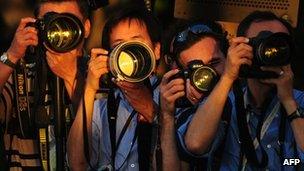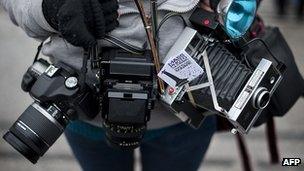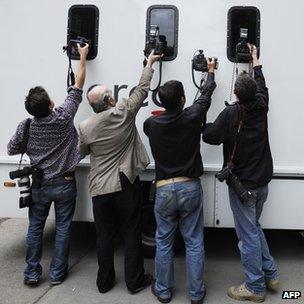A question of ethics: Photographers in the spotlight
- Published
- comments

Photographers are facing enormous ethical questions posed by the allegations aired during the ongoing Leveson inquiry. Here, Max Houghton, course leader in MA Photojournalism at the University of Westminster and a writer on photography offers her personal views on the challenges ahead.
"For a number of years I was relentlessly pursued by 10 to 15 men, almost daily... Spat at, verbally abused... I would often find myself, at the age of 21, at midnight, running down a dark street on my own with 10 men chasing me. And the fact they had cameras in their hands made that legal."
Such was actor Sienna Miller's shaming testimony to The Leveson Inquiry into the culture, practice and ethics of the press, which has shown news photographers in an unflattering light.
Professional bodies such as the British Press Photographers' Association (BPPA), external have been quick to counteract this tarnishing, insisting - accurately - that such behaviour does not typify the approach of the majority of news photographers. Yet in order for any meaningful change in these appalling practices to occur, those of us who work in and with photography are charged with taking this criticism seriously.
Miller's testimony needs to serve as a wake up call for the whole profession, not as an opportunity to trot out the 'we made her who she is today' defence, nor for the principled majority to distance itself from the unethical minority.
Public figures have the right to a private life. Miller became famous because she is good at what she does, and was a lucky winner in life's beauty lottery and is therefore prodigiously photographable. These elements combined do not de facto entitle every aspect of her life to be invaded.
Actress Sienna Miller has told the judge-led inquiry into media ethics how media intrusion had left her in a state of "complete anxiety and paranoia"
The photographers who come to the University of Westminster to study on the course I run, MA Photojournalism, do not, for the most part, want to photograph celebrities. But many of them are interested in photographing in developing countries. Some of them even want to change the world (thank goodness). While the subjects of photographs are as varied as people on this earth - that is indeed what they are - the considerations that apply to taking and using their image are the same.
Many factors come into a play at the moment of squeezing the shutter. Does the photographer have the consent of the person he is photographing? If the person is not capable of giving their consent (if they do not speak the same language, or are injured for example, or even dead), is it appropriate to continue photographing?
If the person in the photograph is in obvious distress or danger, should the photographer put down the camera? Are there circumstances in which the photographer should provide help or assistance? If the photograph is taken, after all these considerations, who will see it? How will its future dissemination affect the people in the photograph?
In her now infamous opening line to The Journalist and the Murderer, Janet Malcolm wrote: 'Every journalist who is not too stupid or too full of himself to notice what is going on, knows that what he does is morally indefensible.'
The author expands on this in an interview with The Paris Review, saying that journalism is not a 'helping' profession, except for in the way that its exponents help themselves to 'what our subjects don't realize they are letting us take'. Ouch. How to argue with her position?

Photographers have found themselves under attack from all sides in recent years, including a series of clashes with authorities relating to the right to take pictures in public
The most serious and considered practitioners are always careful to refer to the practice of making not taking photographs, but is this in fact a case of weasel words? And does knowing and understanding that photography is always a transaction make the act any more palatable? At what point does voyeurism - all photography is surely this - tip into scopophilia, a love of looking?
Among the current concerns of the photographic profession is that Leveson could result in so-called 'French-style' privacy laws - ie stringent ones - which would create as many problems as it would ease.
Photography of public marches and the police handling of them could be out of bounds. Street photography might become virtually obsolete. Imagine a history of photography without Cartier Bresson. While a debate about legislation and how it might benefit photography would no doubt be a valuable exercise, swingeing laws would not eradicate unethical practices any more than marriage prevents infidelity.
Photography exists in an interregnum right now, and is wrestling with new problems as well as difficulties inherent to the medium.
The rise of citizen journalism means of course that anyone with a camera can and does get published. As they are not members of a specific profession, and thus not united by a code of practice, anything goes.
If their imagery goes a step further, some editors might prefer to use their work. Staff photographers are becoming an increasingly rare breed, and this inevitably leads to an influx of freelancers, who are not necessarily working towards a united set of principles.
The demise of newspapers means that editors are ever more desperate to deliver customers to their diminishing advertisers and as such will publish anything they think they will help them in this quest.

The concept of 'public interest' has long since morphed into 'what interests the public'…which, to the dismay of serious news photographers, means a picture of someone who once failed to win on the X-Factor buying a large skinny latte (with their cellulite showing).
It is the duty of contemporary photographers to question continually what they are looking at, and why it is appropriate to permit others to look too. Such self awareness would not limit their practice, but would rather enhance it. And of course many of them do.
While the so called "Stalkerazzi" shame the profession, members of the BPPA and the photographers' branch of the NUJ, external, among others, are creating forums and running events where these and other issues are given serious consideration. They also provide an excellent opportunity for newcomers to consider the boundaries of their profession.
But even when best practice is followed to the letter, photographers might find their images take on other, unexpected forms. Jodi Bieber photographed Afghan women for a Time magazine article, and was aware of the power of her image of Bibi Aisha, external, whose nose and ears had been cut off by members of the Taliban as a punishment for fleeing her husband's home. Knowing Bieber and her work, I am certain she did not seek a sensationalist image, and - importantly - nor has she criticized Time for using the image of Aisha on its cover.
I agree with its usage, but not its accompanying cover strap line: What Happens if We Leave Afghanistan (no question mark). For me, Time turned an image taken with integrity into propaganda.
When the image went on to win World Press Photo, it was then used as the invitation to the subsequent exhibition. While I am not suggesting censorship of difficult imagery, it is not hard to conceive of a more respectful approach to disseminating the image (such as printing it on the inside of a fold-out invitation).
A photograph never exists in isolation. It is always part of a triangulated relationship which involves the photographer, subject and audience.
And photojournalism by its very nature is collaborative, and this means that picture editors, writers, designers, art directors and editors all share responsibility in the ongoing life of a photograph.
Frequently, however, doing the right thing comes naturally. As LIFE photographer Bill Eppridge commented about his unforgettable image of mortally wounded Robert Kennedy, external: "I never hung it on my wall."
Related posts: